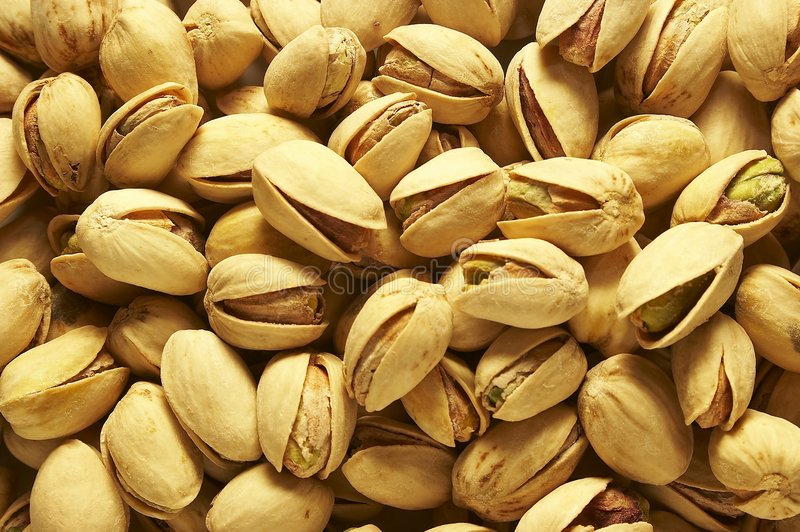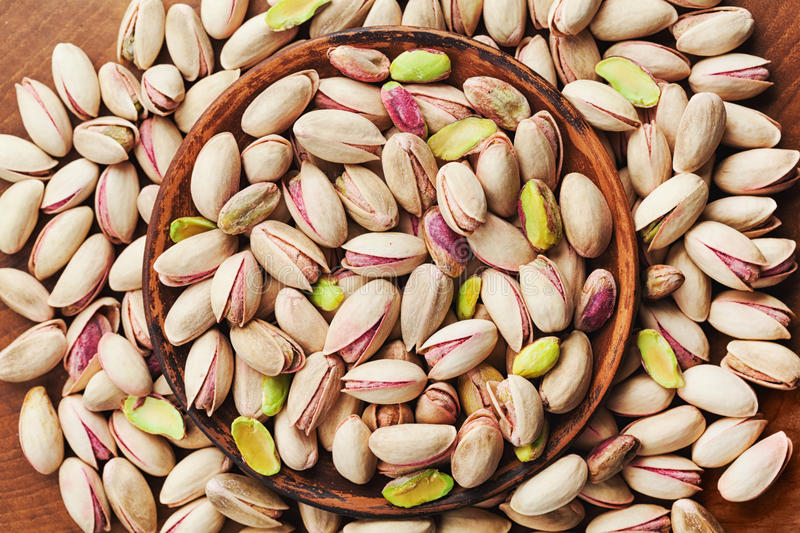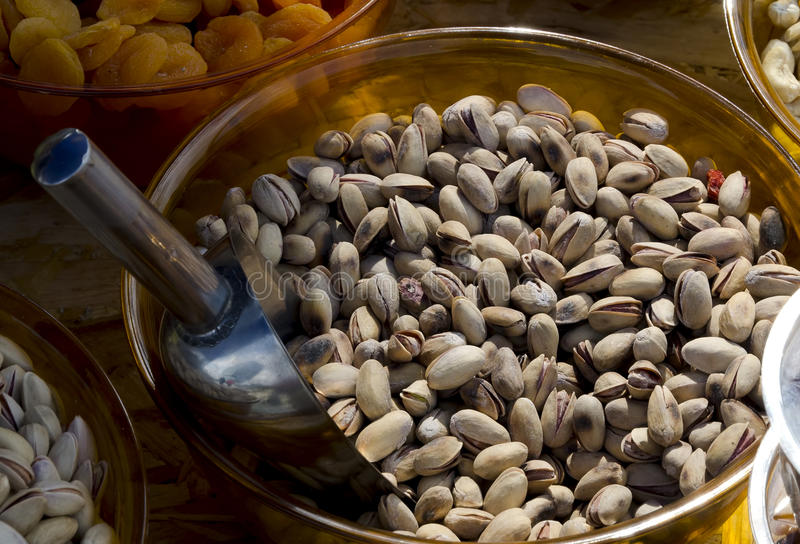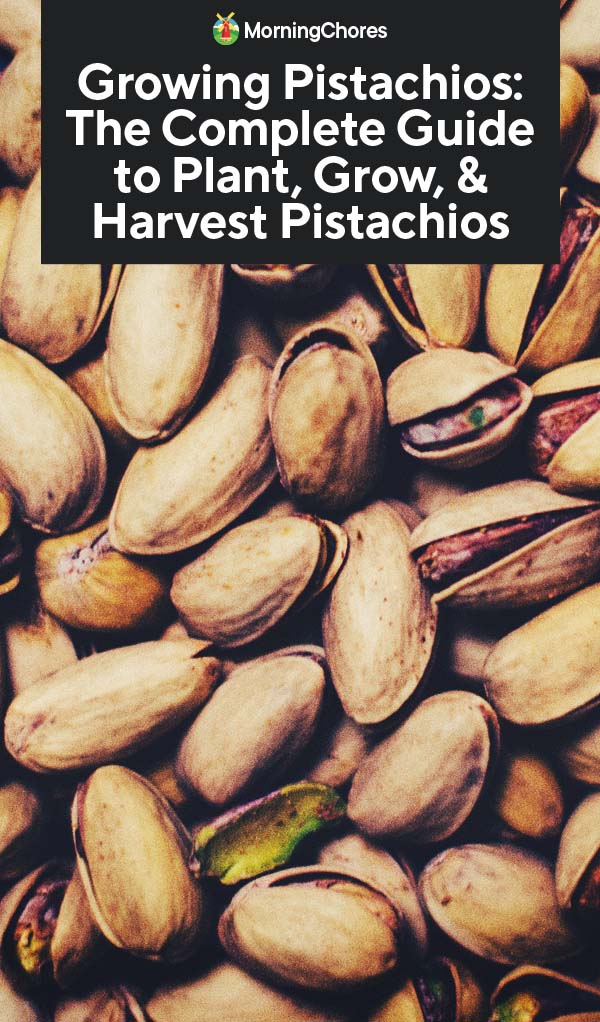THIS POSTING IS NOT YET FINISHED, BUT WILL BE IN A FEW DAYS
Pistachios are one of my favorite snacks. There is something satisfying about cracking them open as a snack, one after another, while watching a movie. Plus, they aren’t bad for your health like some other noshes I could mention. Despite my love for the nutty snack, I always figured growing pistachios was too hard in my region, but I was wrong.

This member of the cashew family isn’t as challenging to grow as you might think. That’s perfect because they seem to be gaining in popularity as a healthy nibble. It’s no wonder more people want to learn about growing pistachios at home. After all, they have some of the fewest calories of the nut family, plus they’re rich in antioxidants, unsaturated fats, vitamins, minerals, fiber, and carotenoids.

The bad news is that growing pistachios is a long term commitment that requires patience. Pistachio trees take around 5-8 years to start to bear fruit, and it can take up to 15 years to get a full harvest. It’s worth it, though, once you first get to crack into your own fresh fruits. Ready for the commitment to grow your own pistachios? Keep reading!

Pistachio Varieties
There are several different types of pistachio plants, but only Pistacia vera is grown commercially. The Pistacia vera tree has long, grey leaves, and grows in USDA plant hardiness zones 7-11.
There are a few types of vera pistachios that grow well in the U.S.
- Platinum is a vigorous grower that can handle some cold. This variety is a clone developed after verticillium wilt nearly wiped out commercial pistachio crops in the U.S.
- Pioneer Gold is another clone that resists wilt. It’s the most widely grown variety in the U.S.
- Kerman is a new type introduced to the U.S. from Iran. It produces large, bright green fruits and bears in 6 years. Plant with the Peters variety as a male pollinator.
- Joley never gained commercial success because it has smaller fruits, but it’s a good option for home growers.
- Red Allepo is popular in Syria. It blooms early and grows crisp, crunchy fruits.
How to Grow Pistachios
Where to Plant Pistachios
The ideal locations for growing pistachios are areas that have cold but not frigid winters, hot summers, and little rain. Semi-arid desert locations are ideal. Pistachios prefer temperatures that are above 100℉ during the day. The trees need winter months that are cold enough to send them into dormancy, around 45℉ or below. Pistachios don’t like high elevations because of the cooler temperatures that reach below 15℉. Pistachios don’t grow well in areas with high humidity.
Seed or Rootstock?
You can either purchase a pistachio tree from a nursery or grow a tree from seed. Growing pistachios from seed can take years. If you’re an impatient person like me, it may not be practical.
Plant in Pairs
You will need more than one pistachio tree. To produce nuts, the female tree needs a male nearby, typically upwind. You’ll need one male pistachio tree for every 15 female trees.
The bad news is that the trees are unisex and you don’t know the sex of a tree until it’s time to bear fruit, which is eight years into its life cycle. That’s why most people plant several trees to help ensure they get at least one male.
The only way to know the sex of your tree ahead of time is by purchasing a grafted sapling or cutting. The sex will be the same as the parent tree.
Growing Pistachios From Seeds
If you decide that you want to start from seeds, you need to buy raw pistachio seeds. Buying directly from a nursery ensures you get the best product, but you can grow trees from the seeds purchased in the grocery store.
Going with the grocery store route is fine, but they can’t be salted or roasted. Those seeds won’t germinate, so it’s useless to try. Most health stores sell raw pistachio seeds.
Here is what you need to do is grow a pistachio tree from seed.
- Put a damp paper towel in a plastic baggie and put the pistachio seeds into the damp paper towel. Make sure you don’t put too many; five seeds is fine. Poke a few holes in the baggie for air circulation.
- Wait a week for the seeds to germinate. The bag needs to be kept at room temperature in an undisturbed spot.
- Once you see sprouts that burst from the seed, transplant it to a cup filled with soil. Make sure the cup has drainage holes. Keep the soil damp, but don’t overwater because it will slow the tree’s growth.
- Over time, you’ll need to transplant into larger pots until it’s time to plant it outside.
The trees don’t like having their roots exposed, so it is easiest to use peat pots as you transplant and finally plant your trees.
Sun and Soil Requirements
The ideal planting site for a pistachio tree receives full sunlight and has well-draining soil. They prefer sandy loam with a pH between 7.1 and 7.8. Pistachios are taproot trees, so the deeper the soil the better.
Spacing
The trees can grow quite large, up to 30 feet in height, so you need to think about the future. Give plants 12-20 feet between trees and 20 feet between rows. Make sure there’s nothing that might get in the way above your trees, such as phone poles or electrical wires. Picking the right spot determines the successful future of your pistachio tree.
Transplanting Your Tree Outside
Seedlings can grow in containers for the first 3-5 years, then they can be placed into your garden. You can also plant seedlings outside in the spring or fall.
The first step is to dig a hole for each of your trees. You want the hole to be twice as deep as the root ball and twice as wide, giving plenty of space for the roots to spread out. Amend the soil as needed.
Place the tree into the hole, keeping it as vertical as you can. No one wants to grow a crooked tree. A level may be helpful to ensure its completely vertical. Do your best not to expose the roots as you plant.
Fill the hole back in with amended dirt, picking out stones, plants, and weeds. Water as soon as you plant the tree to prevent air pockets from forming in the soil.
How to Care for Pistachios
Water Needs
Pistachio trees are native to regions that don’t receive tons of water, so you don’t have to water daily or even weekly. When you do water, you need to do it so that the soil is moist four feet deep.
Plan to water your tree deeply every month. If you experience a lot of rain in one month, skip watering. Watch for yellowing leaves which is an indicator that the tree is receiving too much water.
The trees will go dormant in the winter, so you don’t need to continue watering. Stop around October, which encourages and prepares the tree for dormancy.
Fertilizer
The best time to fertilize your pistachio tree is in the spring after the danger of frost has passed in your area. Try a 10-10-10 fertilizer, which is readily available at most garden nurseries or farm stores. Use 1/2 cup of fertilizer for every inch of trunk diameter at chest height.
Applying fertilizer to your pistachio tree is easy. All you need to do is sprinkle the granules evenly under the tree to 1 foot beyond the drip line. Then, make sure you give the tree 1 inch of water after applying the fertilizer.
Fertilize twice a year during the growing season. Never apply more than 5 cups of fertilizer for each season.
Pruning
Like any of other fruit or nut tree, you’ll need to prune your pistachio trees. Winter is the best time to do a substantial pruning, while the tree is dormant.
Look for branches that cross over each other and for branches that are dead or dying. Most pistachio trees don’t require heavy pruning. You do need to be careful because removing too many branches can decrease nut production.
Establishing the Shape
When you are pruning young trees, pick 3-5 branches you want to use as scaffolding branches for the main structure. Do so in April of the first growing season. Look for branches that are equally spaced on the trunk but not across from each other.
The lowest branch should be 24-32 inches above the soil. Remove any branch that’s lower than that.
Once you picked your main branches, remove the upper branches that might shade the trunk. Pinch those that aren’t the scaffolding branches to 4-6 inches from the trunk.
In June, plan to prune the scaffold branches to 2-3 feet in length. Doing so promotes side branching, while the lateral shoots help to shade the trunk as it grows.
Clear Debris
Rake the soil under and around the tree frequently. Remove the old nuts and leaves the might accumulate, and try to keep the area weed-free. Clearing the debris away helps to prevent pest infestations throughout the growing season.
Pistachios Plant Pests and Diseases
Pistachio trees don’t have a lot of pests and diseases that bug them throughout the year. Here are just a few that you should remember.
Phytophthora Root Rot
This is a soil-borne fungal disease that attacks the roots, making them weak. It can block the water and nutrients that need to be transferred from the root system to the upper part of the tree. Root rot can cause the tree to suffer from slow growth and production.
Alternaria Late Blight
This fungal disease causes black lesions on the leaves or the immature nuts. Severe infestations can cause premature defoliation.
Controlling late blight can be hard. Try appropriate fungicides and use good irrigation practices that reduce the wetness of the ground around the tree.
Keep weeds and debris from around the tree and prune dead or dying branches.
Septoria Leaf Spot
This is another fungal disease that often goes hand-in-hand with Alternaria late blight. Leaves will develop small, round, necrotic spots that can cause defoliation.
Control in the same way as you do Alternaria late blight.
Panicle and Shoot Blight
Yet another fungal disease, this one causes black circular spots on the leaves, shoots, and rachis. The infected leaves will wither and die.
Unfortunately, this fungal disease is hard to control. You need to use a combination of pruning, fungicide, and proper irrigation practices. Prune the infected areas to reduce the problem the next year.
Powdery Mildew
Powdery mildew causes small, powdery white patches on the leaves and fruit, covering the entire leaf. In most cases, its caused by poor circulation and too much shade. Luckily, it won’t cause severe damage to the pistachio.
Pistachio Psyllid
This pest can cause the leaves to turn yellow and necrotic. You might notice curling and drying leaves that drop from the tree prematurely. The leaves might have a sticky honeydew substance on them.
The best way to manage this pest is to apply insecticides, but some of these pests have developed resistance to the standard options.
Verticillium Wilt
Verticillium wilt is a serious problem for commercial pistachio growers in California. Vert is a fungus that prevents the exchange of water inside the tree. The best bet is to plant resistant varieties and destroy infected trees.
Pistachio Dieback
This bacteria causes sooty legions and an excessive amount of resin on trees. Be sure to sanitize tools to prevent spreading the disease, which enters plants through wounds.
Pistachio Twig Borer
If your growing pistachio flowers turn black and fall off the tree, look for larvae and adult twig borer moths. This pest lays eggs in the flowers and then bores into the tree. Use traps to control, along with encouraging natural predators.
How to Harvest Pistachios
The time has finally arrived to harvest your pistachios. It’s been a quick few years, right? You’ll know that the nuts are ripe because the shell pops open and the meat goes from green to a reddish color. It’s important to harvest ripe pistachios as soon as possible because they’re vulnerable to pests.
Harvesting pistachios are easy! Shake the trees, which will release the pistachios from the branches, and make sure you put a tarp under the tree to collect them. Check your fresh pistachios for mold. You don’t want anything but safe and yummy fruits for snacking.
Remember that pistachio trees are biennial bearers, which means that they have a small crop one year and a larger crop the next year.
The Average Yield of a Pistachio Tree
When a pistachio tree is young, the yield ranges from 2.2-4.4 pounds of dry nuts or 5.5-11 pounds of fresh nuts. As your tree gets older (7 to 10 years), expect the production to be around 13-22 pounds of dry nuts or 33-55 pounds of fresh nuts each year.
A fully matured, well-maintained pistachio tree can yield 33 pounds of dry nuts or 83 pounds of freshly harvested nuts.
Get Ready to Go Nuts
Planting pistachio trees requires you to think of the future because it can take over 10 years to have a full harvest. Once the trees produce, you’ll be swimming in the nuts, and it can be a lucrative operation to sell fresh pistachios.
Whether you to grow pistachios for your family or to sell, remember to ensure you have the right climate and pick the perfect location. These trees are hardy and can survive well, so take special care in the early years. They’ll repay you with hundreds of pounds of pistachios.
I USUALLY HAVE NUT SEEDS FOR SALE CONTACT ME>> HERE



